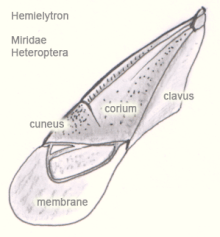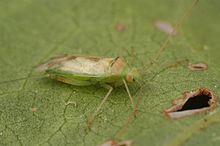

| Miridae | |
|---|---|

| |
| Rhabdomiris striatellus | |
| Scientific classification | |
| Domain: | Eukaryota |
| Kingdom: | Animalia |
| Phylum: | Arthropoda |
| Class: | Insecta |
| Order: | Hemiptera |
| Suborder: | Heteroptera |
| Superfamily: | Miroidea |
| Family: | Miridae Hahn, 1831 |
| Type species | |
| Cimex striatus L.
| |
| Subfamilies | |
| |
| Synonyms | |
|
Capsidae Burmeister, 1835 | |
The Miridae are a large and diverse insect family at one time known by the taxonomic synonym Capsidae.[1] Species in the family may be referred to as capsid bugs or "mirid bugs". Common names include plant bugs, leaf bugs, and grass bugs. It is the largest family of true bugs belonging to the suborder Heteroptera; it includes over 10,000 known species, and new ones are being described constantly. Most widely known mirids are species that are notorious agricultural pests that pierce plant tissues, feed on the sap, and sometimes transmit viral plant diseases. Some species however, are predatory.


Miridae are small, terrestrial insects, usually oval-shaped or elongate and measuring less than 12 millimetres (0.5 in) in length. Many of them have a hunched look, because of the shape of the prothorax, which carries the head bent down. Some are brightly coloured and attractively patterned, others drab or dark, most being inconspicuous. Some genera are ant mimics at certain stages of life. Miridae do not have any ocelli. Their rostrum has four segments. One useful feature in identifying members of the family is the presence of a cuneus; it is the triangular tip of the corium, the firm, sclerotized part of the forewing, the hemelytron. The cuneus is visible in nearly all Miridae, and only in a few other Hemiptera, notably the family Anthocoridae, which are not much like the Miridae in other ways. The tarsi almost always have three segments.[2]

This family includes a large number of species, many of which are still unknown, distributed in more than 1,300 genera. The taxonomic tree includes the following subfamilies and numerous tribes:
Auth.: Schuh, 1976
BioLib includes:
| Miridae |
|
|---|---|
| Authority control databases: National |
|
|---|